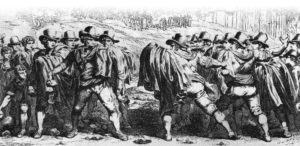
Knife fencing traces its oringins in the Italian folk tradition, at the point that every region can be proud of having their own combat systems.
We have documentations from the 13th century that certify that duels have always been part of tradition and customs.
Masters of arms visited european courts to teach nobles and knights the use of swords; which back then it wasn’t just a battle instrument, but was also an ornament used to resolve arguments and defend honor. Discharged soldiers also taught combat techniques. The plebeians couldn’t access nobility, which could avail of these figures to learn this art of combat. The etiquette didn’t allow interactions, collaborations or friendships between social classes so different from one another; therefore the people who belonged to the lower classes had to copy the techniques in order to learn, creating their own combat methods.
Swords were too expensive for the pleabeians to afford, so (towards the 1600) the knife was no longer just a companion at work, but was available to everyone; “a loyal companion to keep in your ‘saccoccia’ (pocket)” says a roman poem. This is how, in the neighborhoods, the knife was used to resolve disputes between honorable men.
From north to south and on the islands, the tradition rises several knife fencing styles and systems, methods that have evolved within criminal and civilized groups and have been passed on within families.
The knife was the mostly used weapon within the city, it was a protagonist in duels and frequently used to end arguments. Like every tradition, this one was carried on with time. In italy the laws regarding carriage of knifes have always been severe; as a result people started utilizing it less to the point that it almost disappeared completely just like the practice of it. As a consequence the techniques were demonstrated, hence passed on, in folk dances such as ‘la pizzica’ and ‘la tarantella’. In south and central Italy and on the islands there were clandestine schools that taught techniques that belonged to several populations all over Italy (Genoese, Roman, Pugliese…).
These go from the Roman fights with stones and knives, to the duels with a jacket wrapped around one arm as defence and a knife in the other hand.
To convey the idea of the variety of systems and the skills of who practised them, the swiss called the italian master “knife knights”.
Only thanks to these masters this art survived until now and it’s lately being rediscovered owing to researchers who don’t only recognise the cultural patrimony, but also its beauty and its strength; so that the whole world can experience it, just like many years ago.